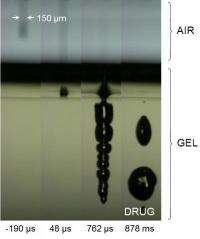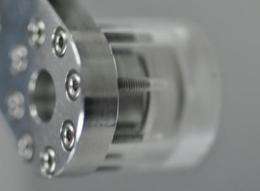Laser-powered 'needle' promises pain-free injections

From annual flu shots to childhood immunizations, needle injections are among the least popular staples of medical care. Though various techniques have been developed in hopes of taking the "ouch" out of injections, hypodermic needles are still the first choice for ease-of-use, precision, and control.
A new laser-based system, however, that blasts microscopic jets of drugs into the skin could soon make getting a shot as painless as being hit with a puff of air.
The system uses an erbium-doped yttrium aluminum garnet, or Er:YAG, laser to propel a tiny, precise stream of medicine with just the right amount of force. This type of laser is commonly used by dermatologists, "particularly for facial esthetic treatments," says Jack Yoh, professor of mechanical and aerospace engineering at Seoul National University in South Korea, who developed the device along with his graduate students. Yoh and his team describe the injector in a paper published today in the Optical Society's (OSA) journal Optics Letters.

The laser is combined with a small adaptor that contains the drug to be delivered, in liquid form, plus a chamber containing water that acts as a "driving" fluid. A flexible membrane separates these two liquids. Each laser pulse, which lasts just 250 millionths of a second, generates a vapor bubble inside the driving fluid. The pressure of that bubble puts elastic strain on the membrane, causing the drug to be forcefully ejected from a miniature nozzle in a narrow jet a mere 150 millionths of a meter (micrometers) in diameter, just a little larger than the width of a human hair.
"The impacting jet pressure is higher than the skin tensile strength and thus causes the jet to smoothly penetrate into the targeted depth underneath the skin, without any splashback of the drug," Yoh says. Tests on guinea pig skin show that the drug-laden jet can penetrate up to several millimeters beneath the skin surface, with no damage to the tissue. Because of the narrowness and quickness of the jet, it should cause little or no pain, Yoh says. "However, our aim is the epidermal layer," which is located closer to the skin surface, at a depth of only about 500 micrometers. This region of the skin has no nerve endings, so the method "will be completely pain-free," he says.
In previous studies, the researchers used a laser wavelength that was not well absorbed by the water of the driving liquid, causing the formation of tiny shock waves that dissipated energy and hampered the formation of the vapor bubble. In the new work, Yoh and colleagues use a laser with a wavelength of 2,940 nanometers, which is readily absorbed by water. This allows the formation of a larger and more stable vapor bubble "which then induces higher pressure on the membrane," he explains. "This is ideal for creating the jet and significantly improves skin penetration."
Although other research groups have developed similar injectors, "they are mechanically driven," using piston-like devices to force drugs into the skin, which gives less control over the jet strength and the drug dosage, Yoh says. "The laser-driven microjet injector can precisely control dose and the depth of drug penetration underneath the skin. Control via laser power is the major advancement over other devices, I believe."
Yoh is now working with a company to produce low-cost replaceable injectors for clinical use. "In the immediate future, this technology could be most easily adopted to situations where small doses of drugs are injected at multiple sites," he says. "Further work would be necessary to adopt it for scenarios like mass vaccine injections for children."
More information: "Er:YAG laser pulse for small-dose splashback-free microjet transdermal drug delivery," Optics Letters, Vol. 37, Issue 18, pp. 3894-3896 (2012). www.opticsinfobase.org/ol/abst … fm?uri=ol-37-18-3894
Journal information: Optics Letters
Provided by Optical Society of America




















